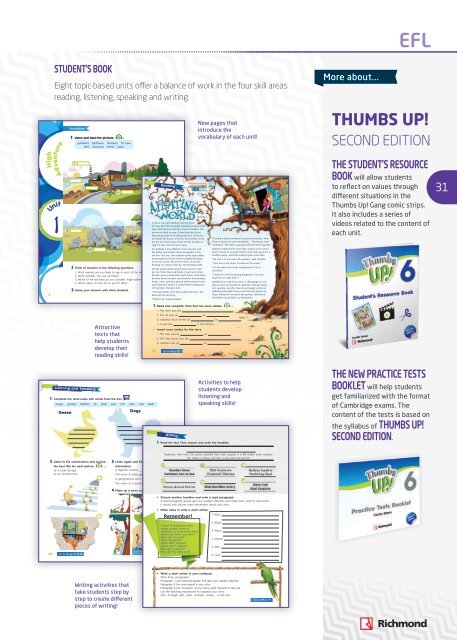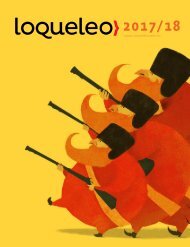CATALOG_RICMOND_2017_INT-op
Create successful ePaper yourself
Turn your PDF publications into a flip-book with our unique Google optimized e-Paper software.
EFL<br />
High<br />
4<br />
Student’s Book<br />
Eight t<strong>op</strong>ic-based units offer a balance of work in the four skill areas:<br />
reading, listening, speaking and writing.<br />
Adventure<br />
nit<br />
1<br />
2<br />
5<br />
Vocabulary<br />
1 Listen and label the pictures. 1<br />
1<br />
grassland lighthouse driveway TV crew<br />
herd backyard hyena dawn<br />
3<br />
6<br />
2 Think of answers to the following questions.<br />
4<br />
7<br />
1. What animals are you likely to see in each of the two places? her cat, Pizza. She read books or sent texts to her<br />
2. What activities can you do there?<br />
friends or just watched the world below. Sometimes<br />
her best friend, Scarlett, and Scarlett’s twin brother,<br />
3. Which of the activities do you consider “high adventure”?<br />
Noah, came, and they played and invented stories<br />
4. Which place is more fun to go to? Why?<br />
and listened to music. It seemed that nothing was<br />
ever going to change, until...<br />
3 Share your answers with other students.<br />
“I’m sorry, Bella, but I have some bad news,” her<br />
dad said one morning.<br />
“What is it?” asked Isabella.<br />
8<br />
Reading<br />
It was a long hot summer. Nobody knew<br />
if it was the effect of global warming or just a heat<br />
wave. But the heat was like a heavy blanket. The<br />
air was as thick as soup. It had been hot for so<br />
long that pe<strong>op</strong>le were talking about it. It was too<br />
hot inside the house; it was too hot outside. It was<br />
too hot to work by day; it was too hot to sleep at<br />
night. It was even too hot to play.<br />
For Isabella it was different. Every day she took<br />
her things and walked down the garden to the<br />
old tree—her tree. She climbed up the r<strong>op</strong>e ladder,<br />
up through the leaves and the tangled branches,<br />
to her tree house. She loved it there. It was like<br />
floating on a boat in the sky. Her floating world.<br />
All day long Isabella stayed there alone or with<br />
New pages that<br />
introduce the<br />
vocabulary of each unit!<br />
Episode 1<br />
“You know there’s nowhere to park around here. And<br />
I have to park my taxi somewhere...” He paused, then<br />
continued, “We need a garage at the end of the garden.”<br />
Isabella looked at her mom (who looked at her cereal<br />
bowl), looked at younger brother Tyler (who gave her a<br />
horrible smile), and then looked again at her dad.<br />
“My tree is at the end of the garden,” said Isabella.<br />
“That tree is old, Bella. It’s dead on the inside...”<br />
“It’s the oldest tree in the neighborhood. It’s so<br />
beautiful.”<br />
“I know it is, but it’s getting dangerous. I’m sorry,<br />
but it has to come down.”<br />
Isabella’s face turned as red as a chili pepper. It was<br />
like an oven in the kitchen. Isabella could get angry<br />
very quickly—but this time she got angry as fast as<br />
lightning! She didn’t say a word. She just picked up<br />
Pizza, walked to the end of the garden, climbed up<br />
the ladder and pulled it up behind her.<br />
More about...<br />
THUMBS UP!<br />
SECOND EDITION<br />
The Student’s rEsource<br />
Book will allow students<br />
to reflect on values through<br />
different situations in the<br />
Thumbs Up! Gang comic strips.<br />
It also includes a series of<br />
videos related to the content of<br />
each unit.<br />
31<br />
Attractive<br />
texts that<br />
help students<br />
devel<strong>op</strong> their<br />
reading skills!<br />
1 Read and complete. Then find two more similes. 41<br />
1. The heat was like .<br />
2. The air was as as .<br />
3. Isabella’s face turned as as .<br />
4. It was like in the kitchen.<br />
• Invent more similes for the story.<br />
1. The tree was as as .<br />
2. The tree house was like .<br />
3. Isabella was as as .<br />
58 Go to PB p. 55<br />
Listening and Speaking<br />
ComiC<br />
1 Complete the mind maps with words from the box. 4<br />
puppy gosling feathers fly beak paw hair bark nest teeth<br />
Geese<br />
Dogs<br />
Writing<br />
Activities to help<br />
students devel<strong>op</strong><br />
listening and<br />
speaking skills!<br />
1 Read the text. Then choose and write the headline.<br />
The new Practice tEsts<br />
Booklet will help students<br />
get familiarized with the format<br />
of Cambridge exams. The<br />
content of the tests is based on<br />
the syllabus of Thumbs Up!<br />
sECond Edition.<br />
2 Listen to the conversation and choose<br />
the best title for each picture. 43<br />
a) A Lucky Escape<br />
b) An Intrepid Mum<br />
Yesterday New York City police arrested their main suspect in a $10 million bank robbery.<br />
His name is Harry, and he’s a nine-year-old parrot!<br />
3 Listen again and find the following<br />
information.<br />
A<br />
B<br />
C<br />
A highway number: _______<br />
The name of baby geese: _________<br />
A geographical area with water: ___________________<br />
The name of a disaster: ________________<br />
D<br />
E<br />
F<br />
4 Make up a story using the pictures.<br />
• Choose another headline and write a lead paragraph.<br />
A lead paragraph should get your readers’ attention and make them want to read more.<br />
It should only include basic information about your story.<br />
• Make notes to write a short article.<br />
Remember!<br />
1. Who:<br />
60<br />
Go to PB pp. 57 & 58<br />
Almost all interesting news<br />
stories answer these six<br />
questions. So think about them<br />
before you write your story:<br />
Who was involved?<br />
What happened?<br />
When did it happen?<br />
Where did it happen?<br />
Why did it happen?<br />
How did the story end?<br />
2. What:<br />
3. When:<br />
4. Where:<br />
5. Why:<br />
6. How:<br />
Writing activities that<br />
take students step by<br />
step to create different<br />
pieces of writing!<br />
• Write a short article in your notebook.<br />
Write three paragraphs.<br />
Paragraph 1: your lead paragraph that gets your readers’ attention<br />
Paragraph 2: the main events in your story<br />
Paragraph 3: the conclusion of your story—what happens in the end<br />
Use the following expressions to organize your story:<br />
First... To begin with... Next... Another... Finally... In the end...<br />
Go to PB p. 59<br />
61




